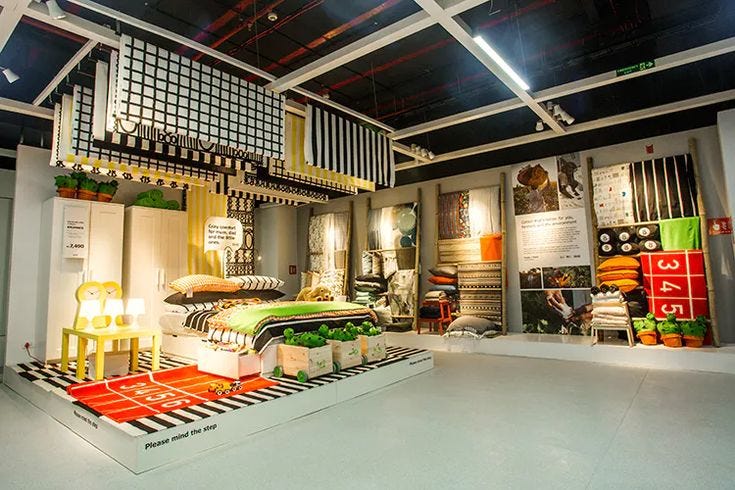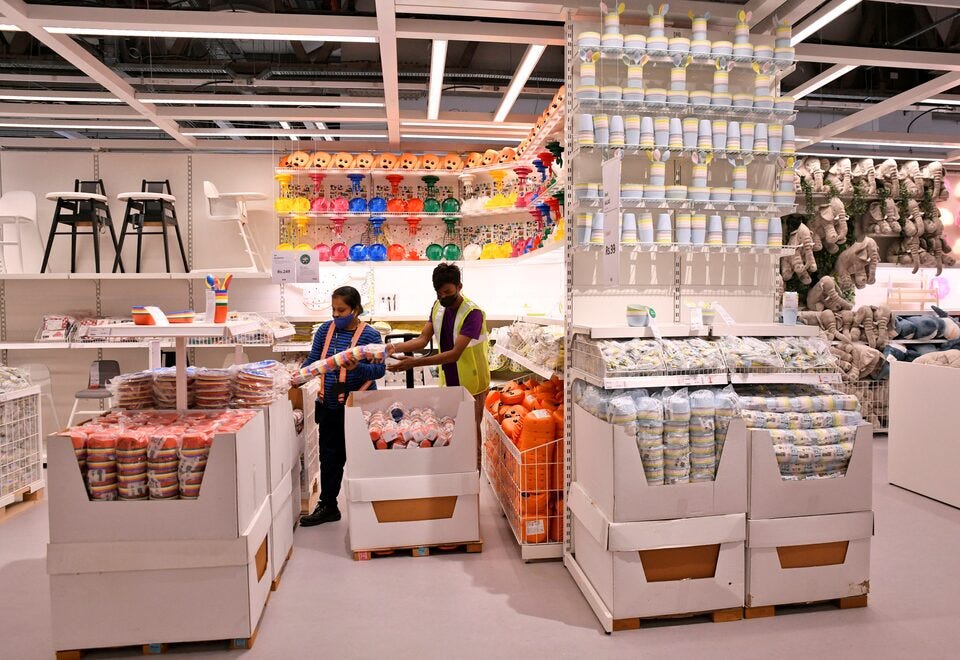IKEA and the Art of the Unseen Script — How You End Up Buying 10 Things When You Only Wanted One
You went in for a bookshelf. You left with 37 items. Here’s the untold story of how IKEA’s Indian stores hack your brain — and your budget.
The Day I Walked Into IKEA Hyderabad for a Rug… And Lost Control
Let me paint a familiar scene.
You’re at IKEA Hyderabad, clutching a shopping list with one item: “1 striped rug, 6x4 ft.”
Three hours later, you’re juggling a cart overflowing with tea lights, plant pots, and a shark-shaped plushie. Your bill? ₹12,000. The rug? Oh, it’s there — buried under 14 other things you never knew you needed.
This isn’t accidental.
It’s psychological warfare disguised as Scandinavian minimalism
The Gruen Effect: Why You Can’t Escape the Maze
IKEA’s stores are labyrinths by design.
The moment you scan your entry ticket, you’re trapped in what retail architects call the “Gruen Effect” — a one-way path that hijacks your sense of direction. Unlike traditional markets where you browse freely, here you’re a lab rat in a blue-and-yellow maze.
The Science: Humans spend 14% longer in stores with forced pathways (Journal of Consumer Psychology).
The Indian Twist: Notice how the Hyderabad store starts with full “home” setups? A ₹8,999 wardrobe looks cheap next to a ₹2.2 lakh “aspirational bedroom.”
Visual Temptation: The Showroom That Sells a Dream
Before you even see the tag on that bed, you see a whole life arranged around it.
IKEA’s fully-furnished room sets are more than decor—they're psychological bait.
You’re not buying a piece of furniture. You’re buying into an ideal.
That well-organized closet, that minimal reading nook, that cozy rug under soft lighting—it all says “This could be your life.”Psychologists call this “mental ownership.”
The moment you imagine something in your home, your brain begins to believe it’s already yours.
And what do humans do when something feels like it belongs to them?
We hate letting it go.The ₹299 Mind Games: How Small Decisions Bleed You Dry
Halfway through the maze, you hit the Market Hall — IKEA’s genius kill zone.
Here’s what’s really happening:
Anchoring Prices: A ₹4,999 dining table looks reasonable next to a ₹12,999 “premium” version.
Charm Pricing: ₹299 (not ₹300) triggers the “less than” illusion. Studies show this boosts sales by 24%.
Basket Psychology: Tiny trolleys fill fast. Once you upgrade to a cart, your brain whispers: “Now there’s space, might as well use it!”
The Math: 5 “small” items x ₹299 = ₹1,495. Repeat across 10 sections, and your ₹3,000 rug budget becomes ₹15,000.
Pricing That Feels “Just Right”
IKEA rarely uses round numbers. Instead, you’ll see ₹2,747 or ₹18,693.
Why?
Because these oddly specific prices make the product feel measured, calculated, even optimized. It gives a sense that the price is what it must be—not a randomly inflated figure.
Then there’s anchor pricing.
Place a ₹48,000 armchair next to a ₹27,500 one, and suddenly ₹27,500 feels like a steal, even if it’s still pricey.
The comparison isn't accidental.
It's engineered.The Final Flourish: Fuel, Effort, and Ownership
You’re nearly done. But not quite. IKEA ends your journey at the food court—a genius touch of emotional reset.
A plate of Swedish meatballs or masala fries for ₹149 does more than fill your stomach. It calms your mind, gives you a moment to reflect (and not in a guilty way).
You feel complete. Like you’ve earned it.Then comes the warehouse section.
You don’t just buy your item. You find it. You lift it. You load it.
This DIY effort gives you a sense of control and ownership over the purchase.
Psychologically, this is powerful.
When you put in effort, the outcome feels more valuable.No Salespeople, Just Scripts
And perhaps the most fascinating part?
No one’s really selling to you.
There are no hovering assistants nudging you toward “today’s offer.” Nor “Can I help you find something?” buzz every 5 minutes.Instead, IKEA uses choice architecture—subtle cues in layout, lighting, signs, and flow that guide your behavior.
You weren’t shopping randomly. You were following a script you didn’t even know existed.IKEA Doesn’t Just Sell Furniture. It Sells a Feeling.
It sells clarity in a world of clutter.
It sells control in the chaos of decisions.
And it sells the illusion of smart choices, while gently nudging your wallet open, one item at a time.So the next time you walk into IKEA for a shelf and come out with 10 other things, don’t beat yourself up.
You weren’t reckless.
You were just part of the most well-designed shopping experience on the planet.And that, dear reader, is not bad spending.
That’s behavioral science at work.
Hey,
Each week, I write and send you a newsletter to bring you up to speed with the information I think you might find interesting.
Do you want me to write about you or an interesting story of yours? Or are there any particular stories you want me to cover?
Not only will your response give me great ideas, but it will also enable me to understand how we can improve the newsletter reading experience.
Just respond to this mail, and let me know :)- If you enjoyed reading this, please share it with your friends.
I want to grow this community as much as I can. (Psst, if you share it on LinkedIn or Twitter, do tag me so I can engage with you)- If this e-mail was forwarded to you and you liked what you read, you can subscribe to Weekly Writamins by AK by clicking here.
It’s free, and I send only one email per week - Most importantly, if WWAK didn’t land in your primary inbox, please move it from your social/promotions tab to your primary inbox so you never miss any of my emails.
See you next week,









